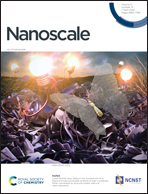Photoluminescence signatures of thermal expansion, electron–phonon coupling and phase transitions in cesium lead bromide perovskite nanosheets
Abstract
In this article, photoluminescence (PL) behaviors of inorganic cesium lead bromide (CsPbBr3) nanosheets are investigated in a broad temperature range from 5 to 500 K. As can be seen from the temperature evolution of the PL peak position, the bandgap blueshift induced by thermal lattice expansion is found to be gradually compensated by the bandgap redshift caused by electron–phonon coupling for the temperature variation from 5 K to 360 K. As the temperature is further increased, the nearly completely compensated PL peak position turns to exhibit a rapid blueshift, again at ∼360 K. Such turning behavior is consistent with an orthorhombic–tetragonal (γ–β) phase transition at this critical temperature. For the PL linewidth, it shows a continuous broadening at temperatures beyond 40 K, suggesting the dominant role of phonon scattering, especially at high temperatures. These findings of temperature dependent photophysical properties of CsPbBr3 nanosheets may provide useful information of their further applications in the emerging nano photo-electronic devices.



 Please wait while we load your content...
Please wait while we load your content...